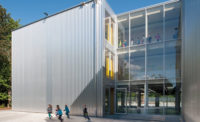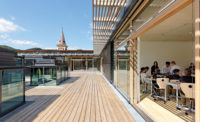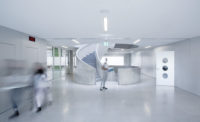German schools traditionally close at 1 p.m., but to accommodate working parents, the Ganztagsschule or all-day school has emerged in recent years. The longer hours are prompting a rethinking of school design, not only to increase energy efficiency and create healthy environments but also to explore how architecture can enable students to relax and stay productive throughout the extended day.
Located in Ergolding, 40 miles north of Munich, the school sits between a highway on the south and a nature preserve and a school for children with special needs on the north. The north-facing entry leads to a four-story atrium that connects diverse ground-level functions'cafeteria, music, and sport facilities to the east, and offices, teacher preparation rooms, art studios, library, and study halls to the west. Extensive interior glazing throughout the ground level, combined with the spacious atrium, establishes a progressive approach: 'It's different from a typical school,' notes Ewald Bichler, assistant principal and a teacher. 'Being so open and bright makes it easier to engage with students.'
To help with navigation, each level is distinguished by a single color applied to flooring and walls in corridors and restrooms'yellow for the ground floor, orange for the second, green for the third, and blue for the science departments on the fourth. Classrooms are accessed by south-facing corridors, which serve as thermal barriers and a buffer against the highway. The corridors' exterior windows feature triple-glazing, with a frit to reduce solar heat gain.
The classrooms, which face north, also have triple-glazed windows to provide day-long, balanced light to improve concentration. On the second and third levels, louvers on the corridors' interior facade direct additional daylight across these spaces and through a clerestory into the rear of the classrooms, while domed skylights enhance illumination on the fourth. LED luminaires supplement daylight in classrooms, all public areas, and the gymnasium.
Areas for informal communication or quiet retreat are dispersed throughout the building. The architects designed leftover spaces resulting from the plan's irregular geometries as gathering areas. They also widened corridors fronting the art studios, library, and study halls to encourage social interaction, and enlarged low-lying window sills to become benches that entice students to linger.
Ventilation, heating, and cooling systems take advantage of the generous corridors, which vary in width from 8 to 10 feet. Supply air is directed mechanically into the classrooms and can be supplemented by operable windows. Exhaust air is directed through the corridors to the atrium, where it is removed. A heat pump, which harvests warm air from a geothermal field north of the school, supplies 85 percent of the school's heating needs. (A gas-fueled boiler delivers the remainder.) Also, hot or cold water runs through the concrete ceiling slabs to help heat or cool interiors.
Far from being an ivory tower, the school welcomes use by the surrounding community. Outside groups, such as children from the adjacent school, access the gym by a separate entry on the east, and the sports hall and changing rooms can be open independently of the rest of the school on evenings and weekends. Non-school events can be held in the atrium, which is an officially designated place of public assembly. And because the building won't reach full capacity until 2019 (currently it is occupied only by grades five to seven), underutilized classrooms can be used for conferences and other outside activities.
The school's proximity to the highway is its only drawback. Though it goes unnoticed indoors, and a new sound-absorption barrier offers some protection, the traffic's din nevertheless penetrates the small, south-facing courtyards opening onto the gym, art rooms, and library.
The school hums with life. During a midday visit in November, the atrium recalled a busy town square, with students piling book bags at the base of the generous stairs, some playing intently at table football, and others poring over study sheets at small tables clustered near the cafeteria, which serves almost as a sidewalk caf'. According to Klaus Wegmann, the Ergolding School's principal, the building's transparency and informality benefit the students and also affect the staff: 'The openness makes a difference,' he says. 'We have more cordial relations, and many people use the familiar form of 'you.' This school is clearly not for more straitlaced types.
PeopleClient: Project Management Owner: User: Architect: Architekturbüro Leinhäupl + Neuber GmbH Personnel in architect's firm who should receive special credit: Project leader: Brigitte Hoernle, Behnisch Architeken, Diploma – Engineering Architect Team Behnisch Architekten Team AB Leinhäupl + Neuber GmbH Architect of record: (please note: an “Arbeitsgemeinschaft” is a working group (joint venture) between two offices, where all important work stages and duties are split 50/50 – this includes design, work both in office and on the construction side, payment and fees, decision making, responsibility etc.) Site architect(s): Engineers: Mechanical and Environmental engineer Electrical engineer Fire Code Energy concept Consultant(s): Lighting Acoustical / structural physics Kitchen planning Orientation system and color scheme Photographer(s): Size: 147,000 square feet Construction cost: 19.2 million Completion date: September 2013 |
ProductsStructural system Gym roof: Glued laminated timber saddleback roof Exterior cladding Level 1 – Level 3 Roofing System Windows, Glazing Skylight: Börner Oberlicht Kuppeln Doors Hardware Interior finishes Partition Wall System: Lindner, Lichte-Systenwand, Forster; Abopart Carpentry: Schäble-Team GmbH (Goldburghausen, Germany) Paints/coatings: Brillux Tiles: Villeroy-Boch, Agrob Buchtal, Starline, Vogue, Ce.Si. Vitra Floor Coverings: Linoleum Armstrong (Level 1-3, hallways) Floor Coating: Remmers (level 0) Carpets: Kugelgarn Fabromont (in classrooms, administrative offices, library etc.) Furnishings Fixed Seating: School Furniture: VS Möbel; Vitra; Performa Textiles: Creation Baumann Lighting Interior Exterior Lighting: Nimbus Group (building) Light Switch / Electrical Installation Conveyance, Elevators Plumbing Energy, Other unique products that contribute to sustainability Ecology Glass Printing*: Glas Trösch * Since all classrooms are angled towards the north, no exterior sun shading was required, and artificial lighting was avoided in the hallways (for additional energy savings). Individually printed glass was used on the south façade to reduce the thermal load. Energy Standard Primary energy demand 104.00 kWh / (m²*a), 40% less than specified by current German Energy Saving Regulations System Highly efficient heat recovery: Add any additional building components or special equipment that made a significant contribution to this project: |













Post a comment to this article
Report Abusive Comment